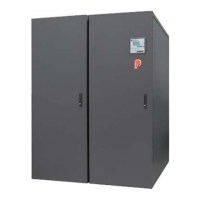Manual code 75803707A.0708
Page 21 of 64
4.7 REFRIGERANT CIRCUIT CONNECTIONS
The pipes must be made from Gelidus type copper, soft annealed for pipes with diameters 26 - 28, and hard
drawn for larger diameter pipes.
To prevent copper dust or swarf from getting into the system, the pipes should be cut using a pipe cutter rather
than a hacksaw. The ends of the pipes should then be carefully cleaned.
If the ends are to be soldered, they should be cleaned with grade 00 glasspaper to eliminate all oxidisation and
dirt. After which the pipe should be inserted in the joint and heated evenly to the melting point of the solder so that flows
easily around the joint
It is important to remember that the pipes should be as short as possible with bends kept to a minimum, as the
cooling capacity of the circuit can be summarised as follows:
Total length of the pipes (discharge and return):
• > 20 m: - 2%
• > 40 m: - 4%
• > 60 m: - 6%
4.7.1 DISCHARGE OR HOT GAS LINE
This is the refrigerant line that connects the compressor outlet to the air-cooled condenser inlet.
To facilitate connection inside the air conditioner, there is a section of pipe approximately 20 cm long, of which
one end is connected to the compressor outlet while the other end is crimped and soldered shut.
During operation of the air conditioner, the discharge line reaches a temperature of 70 - 80 °C. It is not
necessary to thermally insulate this pipe as heat dispersal along this line facilitates correct operation of the refrigeration
cycle. The pipes should only be insulated for safety reasons in cases where there is a possibility that someone could
come into accidental contact with the discharge pipe.
4.7.2 LIQUID OR RETURN LINE
This is the pipe that connects the condenser outlet to the air conditioner inlet valve.
It is connected by soldered joints to the condenser and to the inlet valve. The operating temperature of this pipe
is about 40°C; it does not need to be thermally insulated except in cases where the air conditioning system is also to
operate in winter with temperatures below zero.
4.7.3 NON-RETURN VALVES ON DISCHARGE AND RETURN LINES
WARNING!
In installations with refrigeration circuit pipes longer than 10 metres with vertical pipe runs and the condenser
located higher than the machine, it will be necessary to install a non-return valve on the refrigerant discharge
pipe as near as possible to the compressor outlet.
This will prevent the refrigerant, in the event of the compressor shutdown, from flowing back down the discharge
pipe to the compressor and thus damaging it at the next startup and/or preventing normal operation by causing a high-
pressure blockage. Naturally the valve must be installed vertically and the right way round in accordance the refrigerant
direction of flow.
In the case of pipe sections more than 20 m long and where minimum temperatures below -10°C may be
expected, it will be necessary to install another non-return valve at the outlet of the air condenser, and as close to it as
possible; the valve should be installed vertically to prevent the refrigerant from flowing back to the condenser when the
system is off and the external temperature is very cold, and thereby preventing efficient condensation of the refrigerant
the next time the compressor is started.

